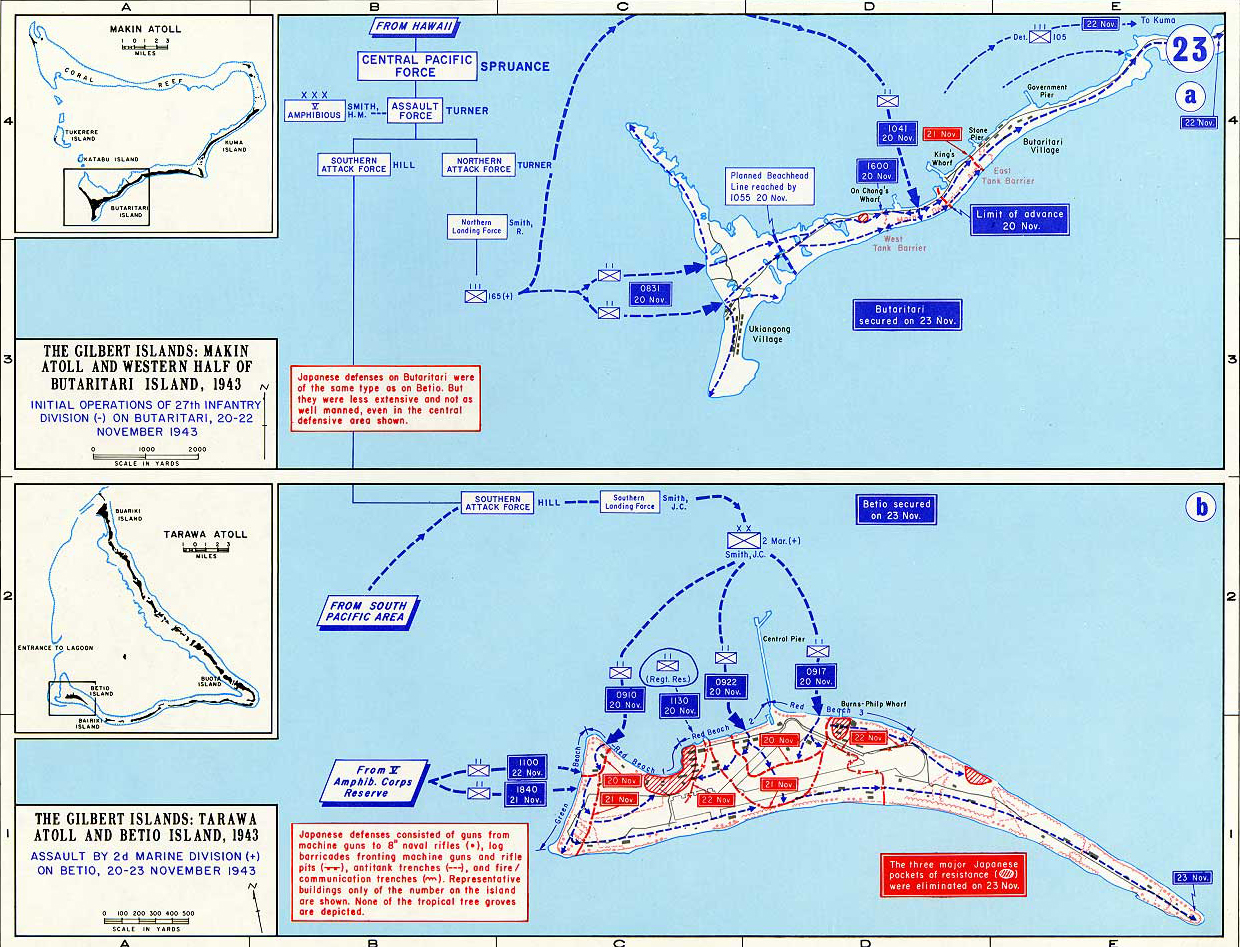Map Description
History Map of WWII: The Gilbert Islands 1943
Operation Galvanic was the codename for the U.S. invasion of the Gilbert Islands
(located roughly halfway between Hawaii and Papua New Guinea), launched
in November 1943. The operation's primary objective was to capture Makin Atoll and Tarawa Atoll from Japanese control to secure bases for
further advances in the Pacific. No other major amphibious landings or battles were part of Operation Galvanic.
The landings were preceded by intense naval and aerial bombardments, but the effectiveness of the pre-invasion fire varied.
At Tarawa, U.S. Marines encountered ferocious Japanese resistance, with entrenched defenders and extensive fortifications leading
to one of the bloodiest battles in Marine Corps history. Makin saw less resistance but still involved significant combat.
The objective was to secure the Gilbert Islands as a strategic stepping stone for further advances westward across the Central
Pacific toward the Japanese-held Marshall Islands and, ultimately, the Marianas and the Philippines.
The U.S. invasion of the Gilbert Islands in November 1943 was also the beginning of the Central Pacific "island-hopping" Campaign
under Admiral Nimitz, with the broader strategy of capturing key islands to advance toward Japan, bypassing others that were
heavily fortified by Japanese troops, to cut these off and isolate them.
Background:
Before the assaults on Makin and Tarawa, the main U.S. focus in the Pacific had been
the Solomon Islands campaign — most notably
the protracted battle for Guadalcanal, which ended in early 1943 — and the Aleutian
Islands campaign in Alaska.
Illustrating:
Battles for Makin and Tarawa, November 1943
The U.S. launched simultaneous assaults on both atolls on November 20, 1943.
- The Battle of Tarawa began at dawn on November 20 and lasted three days, ending in a costly American victory.
- The Battle of Makin also began on November 20 and was secured by U.S. forces after several days of fighting.
Map ⓐ
Makin Atoll and Western Half of Butaritari Island:
Initial Operations of 27th Infantry Division (-) on Butaritari, 20-22 November 1943
The assault on Makin Atoll, specifically the western half of Butaritari Island, was carried out by the 27th Infantry Division
with the objective of capturing the Japanese-held airfield and securing the atoll for future operations.
The operation began with a pre-dawn amphibious landing on 20 November 1943, supported by naval bombardment and air strikes.
The American forces encountered sporadic but determined resistance from the Japanese garrison, which had fortified positions
among the coconut groves and along the shoreline.
From a military strategy perspective, the Makin operation was intended to divert Japanese attention from the main assault on
Tarawa and to provide a base for subsequent advances into the Marshall Islands. Despite logistical challenges and difficulties
in coordinating landings due to coral reefs and tides, the 27th Infantry Division succeeded in securing Butaritari
by 22 November. The lessons learned regarding amphibious coordination, fire support, and overcoming natural obstacles would
inform later Pacific campaigns, highlighting the importance of integrated operational planning and adaptability in island warfare.
Map ⓑ
Tarawa Atoll and Betio Island:
Assault by 2nd Marine Division (+) on Betio, 20-23 November 1943
The battle for Betio Island on Tarawa Atoll stands as one of the most intense and costly amphibious assaults of
World War II. The 2nd Marine Division launched its attack on 20 November 1943, facing a well-prepared Japanese
force that had constructed extensive fortifications, including bunkers, pillboxes, and obstacles along the beaches.
The Marines encountered fierce resistance, compounded by miscalculations of tides that left landing craft stranded
on coral reefs, forcing troops to wade hundreds of yards under heavy fire.
Strategically, the seizure of Tarawa was essential for establishing an airfield and a forward base to support the
Allied advance across the central Pacific. The battle demonstrated both the effectiveness and the limitations of
pre-invasion bombardment, as many Japanese defenses survived the initial onslaught. The high casualties suffered
by the Marines underscored the need for improved intelligence, better landing craft, and more precise coordination
between naval, air, and ground forces.
The experience at Tarawa profoundly influenced subsequent amphibious
operations, shaping U.S. military doctrine for the remainder of the Pacific campaign.
After Makin and Tarawa
The next key objective was the Marshall Islands, located northwest of the Gilberts. The successful seizure of
Makin and Tarawa had provided essential airfields and staging points for the upcoming assault on the Marshalls.
The campaign in the Marshalls commenced in late January 1944, featuring major battles at the Kwajalein and Eniwetok atolls.
Credits
Courtesy of the United States Military Academy Department of History.
Related Links
About World War IIWWII Timelines

